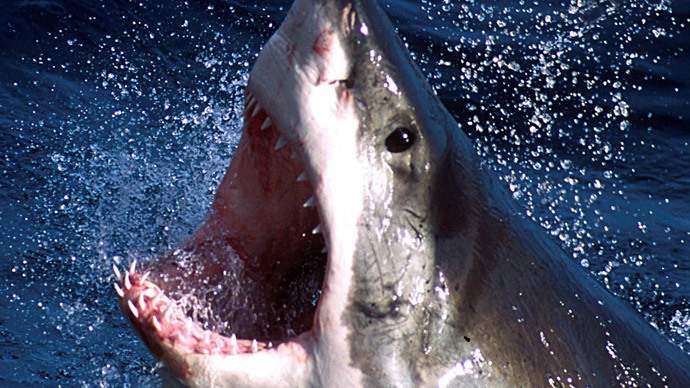Mystery ‘super predator’ hunted in Australian waters after devouring 3-meter shark

Scientists and a filmmaker have gone after an unknown sea monster which they believe has eaten a great white shark traced with a tag. Some say a bigger shark or whale could have been behind the killing, but the gathered data points to other possibilities.
The internet is full of speculation on the nature of the
mysterious sea creature, following the release of a viral YouTube
video by the Smithsonian Channel.
The clip, a trailer for a documentary film, tells the story of
filmmaker Dave Riggs and his journey of investigating a rare
sea-life incident which took place near the Western Australian
coast.
Riggs, who has been contracted to document a satellite tagging
project of Australian great white sharks, says he was
“absolutely blown away” by data gathered from one of the
tags, which washed ashore showing signs of spending days in a
stomach.
“There was no algae growth and it [the tag] was white – it
looked like it had been bleached in stomach acid,” Riggs
told MailOnline.
The tag, which has been analyzed as a sort of “black box” of the
studied three-meter-long shark, showed the creature abruptly
moving some 580 meters (1902 feet) down the continental shelf
before registering a dramatic change in temperature.
The sudden temperature jump from 46 degrees Fahrenheit (7.7
degrees Celsius) to 78 degrees Fahrenheit (25.5 degrees Celsius)
convinced scientists that the tag – which was
“perfectly” fitted under the skin of the great white
shark – was eaten together with its host.
Questions arose regarding what could have devoured a predator
that large. Such speculation prompted the launch of an
investigative documentary dubbed 'Hunt for the Super Predator.'
Several theories emerged after Riggs spoke to experts and whalers
who sailed near the scene at the time of the incident.
Some suggested that it was an even larger “cannibal” white shark
that devoured the smaller one. Great white sharks have been known
to reach six to eight meters (21-28 feet) in size and over three
tons in weight, making the suggestion “plausible,”
according to Riggs.

However, the temperature data does not go entirely well with this
theory, as great white sharks are able to maintain a body
temperature of up to 10-14 degrees Celsius higher than the
surrounding water – and the tag showed a striking difference with
the cold 600-meter-deep water temperature.
While cases of killer whales or orcas attacking sharks are well
documented, it is not typical of these mammal species to dive
several hundreds of meters below the surface of the ocean,
because they need fresh air to breathe. The deepest known dive
for a killer whale is said to be about 260 meters (850 feet).
But such a dive would be possible for another huge sea mammal –
the sperm whale. According to Riggs’ findings, some whalers saw a
group of sperm whales passing along the Western Australian cost
at the time in question. The filmmaker said he plans on
interviewing the whalers for the documentary.
However, it is not clear how the tag’s data would then match the
temperature inside the warm-blooded sperm whale’s belly.
Meanwhile, many YouTube and social media users have commented that they are unsatisfied with the current theories, instead suggesting that krakens, ancient creatures, and even Godzilla are behind the shark's demise.
I've always held hope that megalodon was still alive! What else could eat a 3 meter great white!?! http://t.co/jRdb0R6IWO via @IFLScience
— Melissa Golembieski (@Mgolembieski) June 10, 2014
ONLY Godzilla can eat and swallow a great 3 meter white shark. https://t.co/UJQLn8NEEa
— Gustavo Malet (@GusMalet) June 10, 2014
No investigation needed, we know exactly what ate the 9-foot Great White Shark. #TheKrakenhttp://t.co/VQcq9DTJsSpic.twitter.com/0ey437VU3F
— Kraken Rum UK (@TheKrakenRum_UK) June 9, 2014
Others pointed out that the shark may not have been eaten whole, saying that a predator could have taken a bite out of the shark and swam away with the tag inside its mouth.














